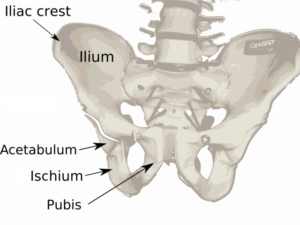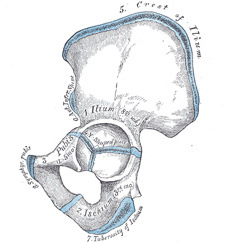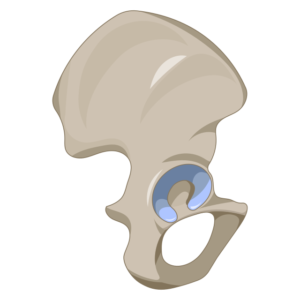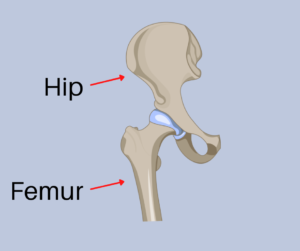The bones of the pelvis at birth.
 The adult pelvis is four bones: two hips, the sacrum, and the coccyx.
The adult pelvis is four bones: two hips, the sacrum, and the coccyx.
But when we’re born, the pelvis is made up of anywhere between 12 to 15 bones.
These bones are separated at birth to allow for a baby’s passage through the birth canal.
What will become the hip bone are three bones—ilium, ischium, and pubis—which will fuse over time.
The Ilium, ischium, and pubis are connected through cartilage and slowly become one bone.
The ischium and pubis fuse first followed by the ilium and the three bones fully ossify somewhere between eighteen and twenty-three years of age.
The ilium, the top and sides of the hip, and the holder of the sacrum are the largest of the three bones.



The sacrum lies between the two insides of the hip bones forming the sacroiliac, or SI, joint.
The ischium is the bottom and strongest part of the bone, its base being the all-important ischial tuberosity where the hamstrings, our inner thigh muscles, and the sacrotuberous ligament attach.
When it comes to a lot of the pain we experience in the hips, groin, and lower back, the bones of the pelvis and their alignment are always involved.
The pubic bones, which connect the front of the pelvis, also anchor the five inner thigh muscles.
The leg bone angles out from the knee and has a neck that turns in towards the pelvis with a ball on the end that sits into the cup in the hip called the acetabulum.
Human birth is fairly fascinating because we are born prematurely.
Our brains are large and so is our head. Too large to pass through the bone of the pelvis after nine months in the womb.
So we are born before we are fully cooked.
Walking at Birth
 As a result, we don’t walk immediately after birth like many grazing animals.
As a result, we don’t walk immediately after birth like many grazing animals.
Even at nine months, we are too big to pass through our mothers’ pelvis easily so accommodations are made.
The sacrum is five bones at birth and the coccyx below the sacrum is anywhere from three to five bones, and they also fuse as we age.
The sacrum and coccyx begin to fuse anywhere between the ages of sixteen to eighteen and are usually completely fused into individual bones by age twenty-six.
But the coccyx and the sacrum maintain the ability to articulate until way later in life.
Somewhere around seventy to seventy-five they begin to fuse and this is particularly important to me.
This post started out being about bones but will finish with muscles and exercise.
Muscle tone is key to aging well.
You don’t have to be super strong but you do want to have balance in all of our muscle groups.
The pelvic floor, which has three layers, has very important muscles called the levator ani.
These are muscles that control continence, and I for one, am obsessed with being continent, until I die.
Watching both of my parents become incontinent late in life was a terribly painful thing and it happens to more people than you might think.
The levator ani muscles control our continence.
If you think about a horse or a cow, they don’t hold in their poop or pee. When they gotta go, they go.
Thankfully we are not the same.
The tone of the levator ani muscles allows us to choose when we go to the bathroom, and in particular, allows us to sleep through the night without peeing our bed.
Developing Good Tone

If we have good tone in the levator ani muscles when we reach our seventies and this joint between the sacrum and coccyx fuse, we will have a good spatial relationship between the coccyx and the pubic bone.
This good tone allows the bones of the pelvis to maintain good alignment.
If we don’t have good tone in these muscles when the joint between the sacrum and coccyx fuses, that is the relationship we have for the rest of our lives.
That is why it is so important to develop this tone early in life and throughout adulthood.
When it comes to good muscle tone the only way to get it is through movement and exercise.
Exercises for the levator ani muscles that best align the bones of the pelvis require movement that involves going up and down.
Walking stairs is a simple way to work the pelvic floor. If you live in an elevator building— skip the elevator.
A lot of athletes choose to run stairs for exercise which is a great option.
Kegel exercises can be good for these muscles but can bring complications if we are too tight on one side compared to the other.
Squatting exercises are also great and I teach them a lot in my yoga classes.
But nothing is better than hiking.
But hiking is the best exercise on earth— and the best exercise for our pelvic floor.
Hiking, preferably in some sort of minimal shoe, requires a great deal of varied movement.
You go up and down. Your feet roll over rocks, roots, and dirt which provides great movement in the bones of the pelvis if you move well.
So do yourself a favor, find a park and a hiking trail, and get out there at least once a week if not more.
